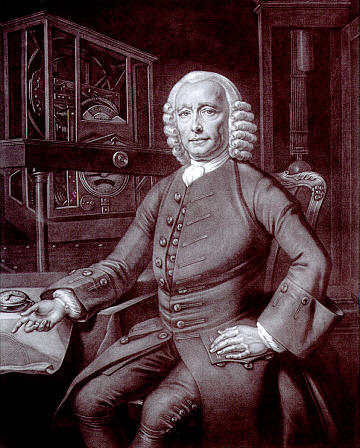Hochschule Augsburg
NTP Service
Network Time Protocol
John Harrison was a self-made man. After creating
very precise wooden clocks that are working until today,
he attacked the navigational problem of longitude.
Between 1730 and 1770, he built five revolutionary
timekeepers that had an error of only a few seconds
over several weeks even on a rolling ship.
There is a nice book about John Harrison's life:
Dava Sobel
"Longitude"
London 1998
ISBN 1-85702-571-7
General
The Network Time Protocol (NTP) is an
Internet protocol based upon IP and UDP.
It is used by software running unattended
as client, server or peer background process
(daemon, service).
Over the network, systems synchronize to each other
and all together to Universal Coordinated Time (UTC),
the legal time in most countries.
Ultimate source of UTC are services operated by
governmental organizations like
PTB in Germany or
NIST in the United States.
Special devices connected to NTP servers receive
time and sync signals via telephone/modem,
from radio broadcasts or the Global Positioning System (GPS).
NTP servers directly referencing such a UTC source
are designated as primary (stratum 1) servers. Most
of all NTP servers synchronize only to other servers
at a higher level (numerically lower stratum) via the net,
as do all clients.
Origin
The Network Time Protocol NTP and its variant
Simple Network Time Protocol SNTP were created by
Prof.
David L. Mills at the University of Delaware.
The development lasted several years and had
many contributors. It was coordinated in an
Internet engineering working group.
The most used Version 3 is defined in RFC-1305.
The actual Version 4 is not yet defined in a RFC,
but is fully backward compatible.
Software
David Mills and several contributors also developed
the ntpd daemon software. It's the only common
NTP software of practical relevance and freely
available.
It not only realizes the complete NTP protocol,
but also is accompanied by an enhancement for the usual
system clock mechanism in Unix. Like a Phase
Locked Loop (PLL) in an electronic circuitry
the software stabilizes the clock.
The daemon supports several modem, radio clock and
GPS devices. It runs on virtually all Unix variants
and is ported to MS Windows and VMS. Modern Unix
variants are already shipped with the ntpd daemon
and utilities.
Source
Replacing the University of Delaware WWW server there is a new
Home of the Network Time Protocol.
You can download the latest distribution of
the ntpd daemon software and link
to other servers offering time software.
Any kind of information regarding NTP and time
is accessible directly or via link.
Several resources
like technical papers, RFC's and
the complete ntpd documentation
are offered in Postscript, PDF or html format.
That's all you need to start.
Setup
There are configurations for many different
machines prepared in the distribution.
They should require no or little patching. The
'Building and Installing the Distribution'
page of the documentation is sufficient
to install the software in most cases.
The most difficult part of setup is
'Configuring NTP and Setting up a NTP Subnet'.
The corresponding documentation page explains
shortly how NTP works. Read that! You have to
plan your own NTP subnet and may wish to embed
it into the world-wide virtual NTP network.
Example configuration files for different
kinds of servers are in a directory of the
distribution. A subdirectory of the
documentation directory contains several
hints for certain machines, the right
subnet structure and more. Read that too!
The
NTP.Servers Web presents a list of all public
primary (stratum 1) and secondary (stratum 2)
NTP servers worldwide.
They are enrolled in this list after announcement
by their operators. Most German stratum-1 servers
offered are operated by universities:
University of Stuttgart
rustime01.rus.uni-stuttgart.de (129.69.1.153)
rustime02.rus.uni-stuttgart.de (141.58.1.170)
The adresses are subject to change.
Please check the access policy of the operator
before using any server.
Also please consider using a geographically close
NTP Pool Time Server since that will be sufficient
in many cases and is easier for you.
Information
For actual questions and answers (sometimes discussions)
there is the newsgroup
comp.protocols.time.ntp. Only reading it will often result
in valuable hints for setting up a NTP subnet.
Important articles from the newsgroup are sometimes collected in
NTP FAQ
and should be scanned for special information about certain machines
(e.g. IBM, HP) or configurations. There is also a
Non-technical Mini-HOWTO and FAQ on NTP (accompanying
the NTP FAQ) for 'Understanding and using the Network Time Protocol',
worth reading indeed.
2004-10-30

